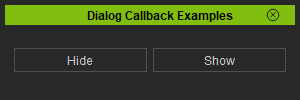Difference between revisions of "IC Python API:Dialog Callbacks"
Chuck (RL) (Talk | contribs) m (→Testing Dialog Callbacks) |
Chuck (RL) (Talk | contribs) m (→Testing Dialog Callbacks) |
||
| Line 91: | Line 91: | ||
dock_window.Show() | dock_window.Show() | ||
</syntaxhighlight> | </syntaxhighlight> | ||
| + | |||
| + | |||
| + | == APIs Used == | ||
| + | |||
| + | You can research the following references for the APIs deployed in this code. | ||
| + | |||
| + | <div style="column-count:4; -moz-column-count:4; -webkit-column-count:4"> | ||
| + | * [[ IC_Python_API:RLPy_RDialogCallback#__init__ | RLPy.RDialogCallback.__init__() ]] | ||
| + | * [[ IC_Python_API:RLPy_RUi#CreateRDockWidget | RLPy.RUi.CreateRDockWidget() ]] | ||
| + | </div> | ||
Revision as of 18:22, 1 October 2019
Contents
- Main article: RL Python Samples.
This article will help you understand the RDialogCallback class at a deeper level. Even though this class only supports three event types, their interactions and initiation can be complex. For example, when the user docks a window, the Hide event is triggered followed by a Show. The following chart goes into more detail:
| Action / Python Call | Triggers | Notes |
|---|---|---|
| Docking | Hide -> Show | |
| Undocking (Drag) | Hide -> Show | Show() command is ignored if the window is visible. |
| Undocking (Release) | Hide -> Show | |
| Closing | Close -> Hide | |
| Hide() command | Hide | Hide() command is ignored if the window is not shown. |
| Show() command | Show | |
| Close() command | Close -> Hide | Close() command can be executed even when the window is not show. |
Notice that Hide always executes after a Close. Therefore, you should always put your script variable clean-up procedures under the Hide event. Under the condition that Hide event is never used, then your clean-up procedures can be housed under the Close event.
Testing Dialog Callbacks
You can use the following script to test and trigger the Dialog Callback events. Try interacting with the buttons, docking, undocking, and closing the window while watching the Console Log feedback (Script > Console Log).
import RLPy
from PySide2 import QtWidgets
from PySide2.shiboken2 import wrapInstance
class DialogCallback(RLPy.RDialogCallback):
def __init__(self):
RLPy.RDialogCallback.__init__(self)
def OnDialogHide(self):
print("The dialog window is Hidden")
def OnDialogShow(self):
print("The dialog window is Shown")
def OnDialogClose(self):
print("The dialog window is Closed")
return True
dock_window = RLPy.RUi.CreateRDockWidget()
dock_window.SetWindowTitle("Dialog Callback Examples")
dock_window.SetAllowedAreas(RLPy.EDockWidgetAreas_RightDockWidgetArea)
hide_button = QtWidgets.QPushButton(text="Hide", minimumHeight=24)
hide_button.clicked.connect(lambda: dock_window.Hide())
show_button = QtWidgets.QPushButton(text="Show", minimumHeight=24)
show_button.clicked.connect(lambda: dock_window.Show())
main_widget = QtWidgets.QWidget()
main_widget.setLayout(QtWidgets.QHBoxLayout())
main_widget.layout().addWidget(hide_button)
main_widget.layout().addWidget(show_button)
dock = wrapInstance(int(dock_window.GetWindow()), QtWidgets.QDockWidget)
dock.setFixedWidth(300)
dock.setWidget(main_widget)
dialog_callback = DialogCallback()
dock_window.RegisterEventCallback(dialog_callback)
dock_window.Show()
APIs Used
You can research the following references for the APIs deployed in this code.


